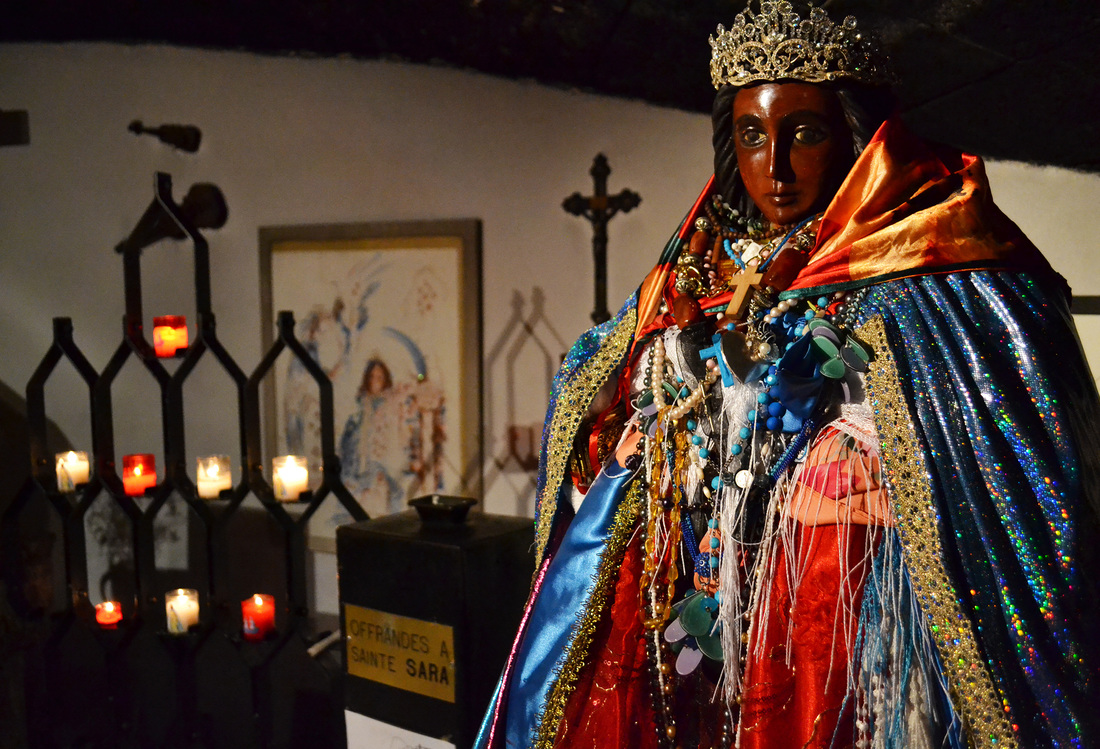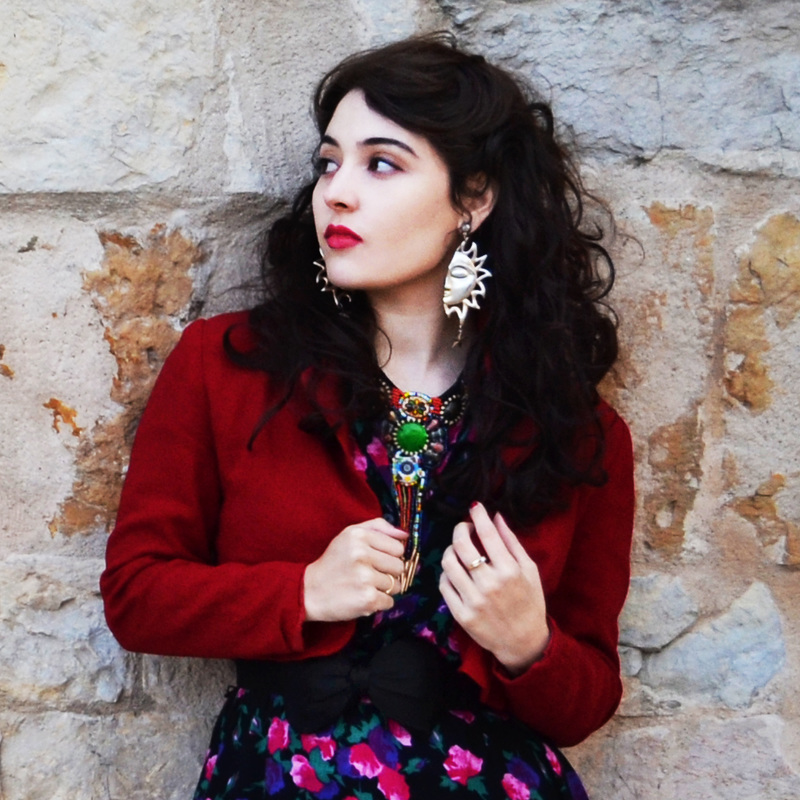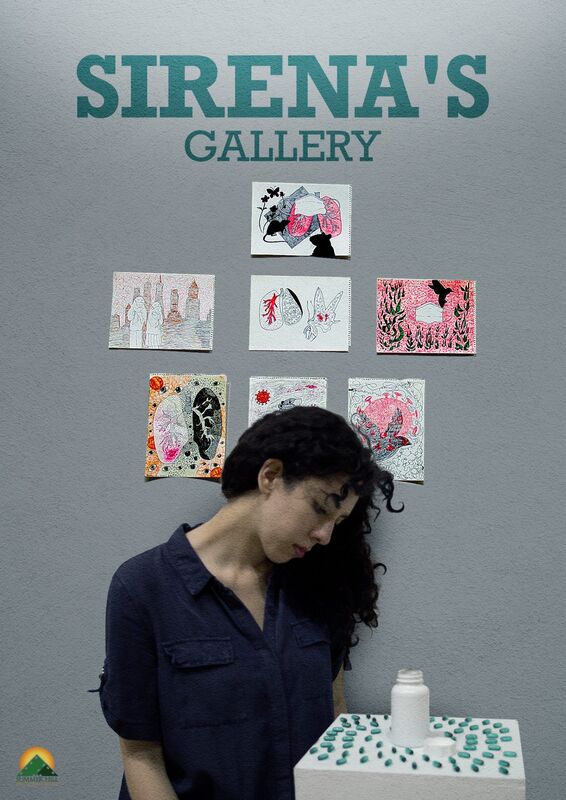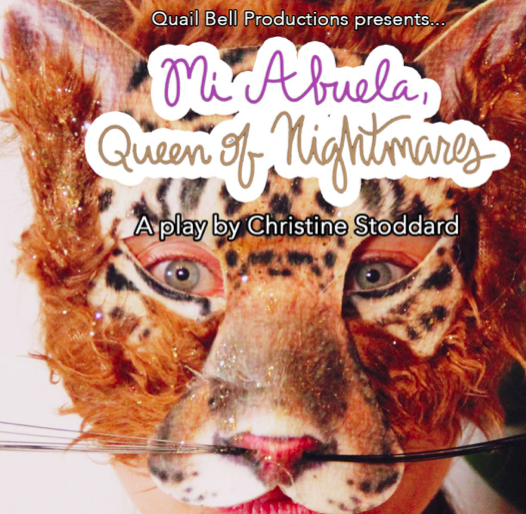|
The Breadcrumbs widget will appear here on the published site.
Sara-la-Kali: The Gypsy Pilgrimage
By Tatiana Eva Marie
QuailBellMagazine.com *Author's Note: My francophone tongue is translating the word “gitan,” which simply designates Roma from the South of France and Spain, into “Gypsy.” There is no negative connotation here.
There is no place in the world that speaks more of my childhood than the wild and mysterious region of Camargue and its emblematic village, Les-Saintes-Maries-de-la-Mer (Saint Marys of the Sea). I spent many a summer there chasing lizards and daydreaming by the misty saltwater lagoons. It is a region of Provence that stands apart from the rest of the South of France and is revered as a land of legend, mysticism and revelation. Camargue is a national nature reserve listed as a UNESCO World Heritage Site situated between the Mediterranean Sea and the two arms of the Rhone Delta, which explains its fascinating geography comprised of lagoons, sandbars and marshlands. This kind of exotic landscape is very unusual in France and has worked wonders on the imagination of its people. It is a land of freedom, inhabited by pink flamingos, white horses and undaunted natives whose somber stares and rugged grace betray the secrets they have learned from their magic earth. Never have I felt more purity and nobility in any other place in the world, it is like trespassing into a fairytale and finding every living plant and creature sharing the same essence and cry for liberty.
Les-Saintes-Maries-de-la-Mer has been a very important Christian pilgrimage destination at least since the 14th century due to a beautiful legend surrounding the founding of the village. The three Marys – Mary-Magdalene, Mary-Salome and Mary-Jacobe – and their servant Sara were driven out of Palestine by the Romans around the year 42 AD and condemned to drift till their deaths on a boat with no oars or sails. They were saved when their boat was miraculously led through the waters and they peacefully landed on the shores of Camargue. Mary-Magdalene continued her journey to the east where she became a naked troglodyte (in the cave of Sainte-Baume) but the other ladies decided to settle in the area and founded the village that now bears their names. The version of the legend celebrated in modern times is believed to stem from the genius of Jacques de Voragine, author of The Golden Legend, written in the 1260s. Scholars believe the Christian worship of the three Marys was substituted to the pagan worship of the three Matres, the mother goddesses of the Roman-influenced Celts. In any case, this particular location was always a sacred site, with evidence of worship to Artemis/ Diane, Mithra, the Marys/ Matres and Sara the black virgin.
The case of Sara-la-Kali (the black Sara) is particularly interesting and is possibly a later addition to the legend of the three Marys. The Roma may have started worshiping her as their patron saint as soon as they settled in the South of France in the early 15th century, when the legend was extremely popular. They were originally nomadic travelers from India and, having retained many of their native beliefs and traditions in some shape or form, recognized in the dark-skinned Saint Sara an avatar of their own goddess Kali. For hundreds of years, on May 24 and 25th there has been a ceremony attended by Roma and Catholics who come from all of Europe to bring Sara and the two Marys back to the sea, where they ritually submerge their effigies. In the past, many measures of discrimination were taken against the Roma in an attempt to limit their participation in the Catholic celebrations. Thankfully, these were put to an end in 1935 by the influence of the dashing Marquis of Baroncelli, who was very attached to the traditions of Provence and sought to protect them at any cost. As an adolescent, I was very attracted by Eastern European folklore. Trying to reconnect with my roots suddenly seemed important, both as a potential adult and growing artist. My mother had emigrated from Romania as a young woman, leaving a poor and difficult life behind. She wanted nothing to do with her past anymore but ended up unconsciously raising me the way she had been raised… but in Switzerland. The culture clash was very confusing to me. When I started discovering my origins, it opened so many doors inside. I felt like I belonged to something at last. With my mother, who is a violinist, I began exploring the music she once held dear. She took off her shoes. We went out and played on the street. I wrote a play inspired by the Romani diaspora from India to the Mediterranean, showing how the different cultures in Eastern Europe – the Roma, the Jews and the local populations – mingled their music together: a powerful example of music as the eternal pacifying link between strangers. As I read more and dug deeper, my researches ironically brought me back to my childhood summer village and the Sara I had worshipped without understanding what she stood for. Last month, my inner voyage officially came full circle when I fulfilled my adolescent bildungs-fantasy of partaking in the Saint Sara pilgrimage. It is quite a unique festival, loud and colorful, sometimes rude and weird, always filled with music and dance, sweat and tears of devotion. There was no parking in the village, so I started out the day by walking for a good fifteen minutes in the hot sun along a crowd of people down the only road that leads to the fortified church. A beautiful road, lined with red poppies, while horses rested in the shade and flamingos gracefully flew over our heads. As soon as we entered the small center, everything seemed to burst alive with music, the bustling of impatient people, mothers with many small children clinging to their long skirts, themselves sheltering skittish or sleepy puppies in their arms. Two proud and radiant flamenco dancers with raven black hair furiously stomped their feet while a totally unrelated Gypsy woman and her band played a very tragic song about being pregnant against her parents’ will. Also the three same local Gypsy women I recognized as the ones who were always trying to sell you something, sometimes tugging at your clothes or cursing under their breath if you politely turned them down. I quickly walked past them. I made my way to the church. There was a line to go down into the hot crypt and people were pushing and complaining. It made me laugh. Then all of a sudden I saw her, my familiar Sara, eager fathers holding babies up to her face and young women ceremoniously laying shawls on her wooden shoulders. When I exited the crypt, mass was starting in the church and transmitted through the entire village via loudspeakers. People gathered very disorderly, just as if we were all a big family who didn’t need to be polite with each other anymore. Little girls were perched in trees with flowers in their hair, like delightful giggling birds, and the roof of the church was overflowing with pilgrims. The crowd chanted “hail Sara, hail the Saints Mary of the Sea!” with booming, happy voices. When Sara was carried out of the church, the elegant Gardians were there on their graceful horses, with their pretty wives dressed in traditional Arlesian costumes, waiting to escort the saint through the village back to the shore where she first set foot many centuries ago. The official procession was made up of children singing hymns, Catholic priests carrying relics, villagers bearing large crosses of flowers and smiling Gypsies walking with their guitars and singing. I was running to always be a step ahead of them.
The author, Tatiana Eva Marie.
When I got to the beach, I was amazed by the amount of people waiting there, covering each rock, each corner like a swarming blanket. In a state a wild anticipation, I somehow made my way through the crowd, went straight to the sea, took off my sandals and let the cool water caress my tired feet. And then in an instant, Sara was on the beach and everyone rushed towards her. At some point I remember fearing I might get crushed, but immediately decided Sara would never allow that. I joyfully laughed at myself for such a thought. It made me happy. The horses were nervous from all the noise as they entered the water. Sara was returning to the sea. I could feel a strong rush of emotion connect us all.
Then all of a sudden a huge roar of laughter: one of the Gardians got kicked off his horse into the water. The priest covered his eyes and smiled. As Sara was immersed, the sea was blessed by her presence and she was in turn blessed by the sea. At that moment, many of us dipped our fingers in the salty waters and made the sign of the cross on our foreheads, torsos – some women on their bellies, for fertility. And then it was over. The procession was heading back to the church and the crowd started dispersing. Very quickly, little circles formed on the beach around musicians from all of Europe, and the entire world seemed to suddenly burst into music. That’s when I understood that the essential beauty of this pilgrimage lies in this kaleidoscope of people from different cultures and standings in life coming together to celebrate their common love for tradition. I felt intoxicated with all the sounds that seemed to come from the four corners of the Earth: Manouche guitars, a Serbian brass band, Romanian violinists, some kind of oriental percussions, an old Romani man playing Djelem Djelem on a nomadic piano and French girls singing in Russian. Musical fireworks. I was exhausted and decided it was time to give my heart a rest by sitting somewhere with a fresh glass of Listel. I couldn’t believe I had finally done it. I had come back to the beginning. This village and its land is my last refuge, the innermost box where my heart truly lies. It is my father reading the story of Crin-Blanc to me while I dozed off to the monotonous lullaby of the invisible cicadas, it is scraping knees in the garrigue and spying on frogs in the lagoon by the moonlight. The smell of lavender, thyme and rosemary, the saltwater leaving white traces on my burnt skin. Holding my breath for the brave men who jumped into the bull-fighting arena and learning how to twirl my wrists to the sound of the Gypsy guitars. It is also 4-year old me, tasting the freedom of my first little horse, Vanille, as she trotted along the beaches of eburnean sand. Everything I saw, ate, touched and smelled was a magic relic filled with wonders no one ever had to explain. There is no place on earth where I feel more at home, and yet I know I shall always come to Camargue as a deferential awe-struck pilgrim into a land of legends.
#Real #RomaniCulture #Pilgrimage #MarysOfTheSea #CulturalConnections #SaintSara #EasternEuropeanFolklore
Visit our shop and subscribe. Sponsor us. Submit and become a contributor. Like us on Facebook and follow us on Twitter.
Comments
Silvia Estela
8/6/2015 03:07:31 am
What a beautiful piece! I enjoyed reading so much about the magical presence of this land and its traditions! Looking forward to more of your writing. 8/5/2017 12:05:57 pm
Thank you so much for this beautiful piece!! Looking forward to more of your writing as well. Comments are closed.
|
|











